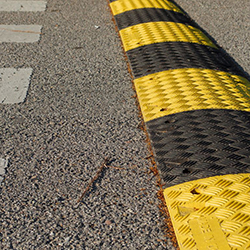Controlling vehicle speed is crucial in areas where pedestrian safety is a concern. Speed bumps and humps are common traffic-calming devices that play a vital role in reducing accidents and enhancing safety. But what makes them so effective? Join us as we delve into the benefits of speed bumps and humps and how they contribute to safer roads and parking lots.
What Are Speed Bumps and Humps?
Speed bumps and humps are raised devices installed across roadways or parking lots to slow down vehicles. While they serve a similar purpose, they differ in design and application:- Speed Bumps: These are narrower and more abrupt, typically used in parking lots and areas with low-speed limits to force drivers to slow down significantly.
- Speed Humps: These are wider and less severe than bumps, designed to slow vehicles gradually over a longer distance, making them ideal for residential streets and areas with moderate speed limits.
The Benefits of Speed Bumps and Humps
1. Reduced Speed and Enhanced Safety: The primary function of speed bumps and humps is to reduce vehicle speed, especially in high-risk areas like pedestrian crossings, school zones, and parking lots. By forcing drivers to slow down, these devices significantly reduce the likelihood of accidents. 2. Increased Pedestrian Safety: In areas with high pedestrian traffic, speed bumps and humps help protect pedestrians by ensuring that vehicles approach crossings at safer speeds. This is particularly important in school zones, parks, and residential areas. 3. Traffic Flow Control: Speed bumps and humps can be strategically placed to manage traffic flow and discourage cut-through traffic in residential neighborhoods. This helps maintain a quieter, safer environment for residents. 4. Cost-Effective Traffic Calming: Compared to other traffic control measures, speed bumps and humps are relatively inexpensive and easy to install. They offer a long-term solution with minimal maintenance costs. 5. Versatility: These devices can be installed in various locations, from parking lots to private roads, making them a versatile option for controlling speed and enhancing safety in multiple settings.How to Choose the Right Speed Bumps and Humps
When selecting speed bumps or humps for your area, consider the following factors:- Material: Rubber speed bumps and humps are durable, weather-resistant, and offer a flexible solution for different road surfaces. Asphalt and concrete options are also available for more permanent installations.
- Height and Width: The height and width of the bump or hump will determine its effectiveness in slowing down traffic. Choose dimensions that are appropriate for the speed limit and traffic conditions in the area.
- Visibility: Opt for products with reflective strips or bright colors to ensure they are easily visible to drivers, especially at night or in low-light conditions.
- Installation and Maintenance: Consider how easy the device is to install and whether it requires ongoing maintenance. Rubber options are typically easier to install and maintain compared to asphalt or concrete.

